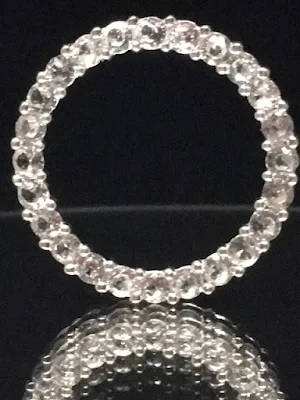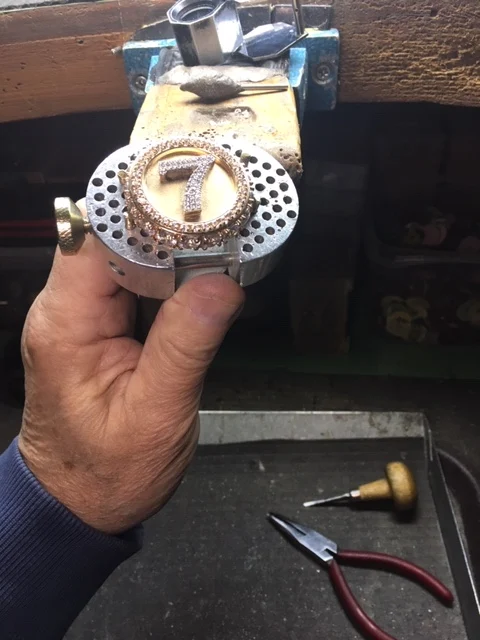I was asked to write an essay on this rather interesting topic. I needed ideas from the "Orchid/Ganoksin" group of jewellers and this is just one of them!
From 'my few years of experience', here is what I found & as well as the techniques that will be 'carefully' explained.
Past history on this "demo-pendant": My two daughters gave my wife this round pendant that was bought from an upscale jewellery store. As you can see that these stones were of a 'mediocre quality', I think they were only 'white spinels'. I'm now replacing them with "Swarovski, Zirconia" stones, in my personal opinion is these stones are much better quality and of a higher lustre now for my wife now to wear.
BTW, all of my demo-pieces are using "Swarovski, Zirconia" as they have (I think) a "Mohs Hardness" at 8.5! (You can correct me via email if I'm wrong!)
What tools are needed for this essay/exercise?
1) Large round bur, this is to carve a 'round gallery' for the Pavilion of the stone!
2) Copper, or Brass pusher...but please, DO NOT USE A STEEL PUSHER!
3) Bud-shaped bur. The #006 bur is to make two bearings, on both sides of each claw!
4) Ring clamp for your own setting project). For this demonstration, I'm using my "Shellac-Stick" as this demonstration is of a 'flat pendant'.
5) 10x power loupe. This is to be used for closer examination, other than your Opti-visor @ #5 power lens! I'm using my Iphone setting with the stronger 'close-up' feature on the camera, plus an additional 'close-up' lens attachment.
6) Pumice wheels of #180 grit, these will be in a Tapered shape.
7) Pumice wheel of #1,000 grit, (Pink coloured wheels) 'Tapered' shape as same as the #180 grit Pumice Wheel!
8) Cup-Shaped burs a.ka. #77B. The size of bur #012 is used this essay as the claws are only 1.0 mm. I always make my bur selection a size la rger, never 'the same as'.
9) Smooth jaw 'pair of pliers'. These are to be used in moving the two 'claw tips' together. These two claws must be opposing each other when finished!
10) Wax-dob. This is used to pick up the stone. Don't use tweezers, the stone might fly off 'by parcel delivery' and never to be seen again..:>)
Let's be honest, can you see the difference between these two pendants?..:>) The top photo is the 'store bought' and the one below, is after some serious modifications! As you can observe how transparent these 'white spinels' seem to be and with no overall shine to them. Just a poor quality of stones.
10) Wax-dob. This is used to pick up the stone. Don't use tweezers, the stone might fly off 'by parcel delivery' and never to be seen again..:>)
















































